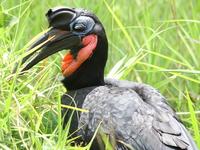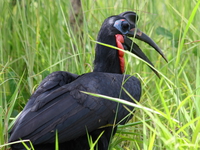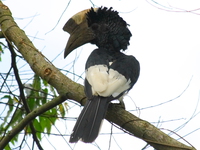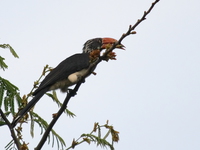ground hornbill
Hornbills (family Bucerotidae) are a group of birds characterized by a long, down-curved bill, sometimes with a casque on the upper mandible. Frequently, the bill is brightly coloured.It also can be founded at Sarawak,Malaysia.But, the birds are now in endangered.The animals is a protected specis in Malaysia. Both the common English and the scientific name of the family refer to the shape of the bill, "buceros" being "cow horn" in Greek. In addition, they possess a two-lobed kidney. Hornbills are the only birds in which the first two neck vertebrae (the axis and atlas) are fused together; this probably provides a more stable platform for carrying the bill.
The Bucerotidae include some 57 living species, about 10 of them endemic to the southern part of Africa. Their distribution ranges from Africa south of the Sahara through tropical Asia to the Philippines and Solomon Islands. Most are arboreal birds of dense forest, but the large ground-hornbills (Bucorvus), as their name implies, are terrestrial birds of open savanna.
Hornbills are omnivorous birds, eating fruit, insects and small animals. They cannot swallow food caught at the tip of the beak as their tongues are too short to manipulate it, so they toss it back to the throat with a jerk of the head. They range in size from the Black Dwarf Hornbill (Tockus hartlaubi), at 102 grams (3.6 oz) and 30 cm (1 foot), to the Southern Ground-hornbill (Bucorvus leadbeateri), at up to 6.2 kg (13.6 lbs) and 1.2 m (4 feet). Males are about 18% larger than females on average, and some species have sexual dichromatism. In the Abyssinian Ground-hornbill, for example, pure blue skin on the face and throat denotes an adult female, and red and blue skin denotes an adult male.
Hornbills generally form monogamous pairs. The female lays up to six white eggs in existing holes or crevices, either in trees or rocks. Before incubation, the females of all Bucorvinae�sometimes assisted by the male�begin to close the entrance to the nest cavity with a wall made of mud, droppings and fruit pulp. When the female is ready to lay her eggs, the entrance is just large enough for it to enter the nest, and after she has done so, the remaining opening is also all but sealed shut. There is only one narrow aperture, big enough for the male to transfer food to the mother and the chicks. During the incubation period the female undergoes a complete moult. When the chicks and the female are too big to fit in the nest, the mother breaks out, then both parents feed the chicks. In some species the mother rebuilds the wall, whereas in others the chicks themselves rebuild the wall unaided. The ground-hornbills are conventional cavity-nesters instead.




